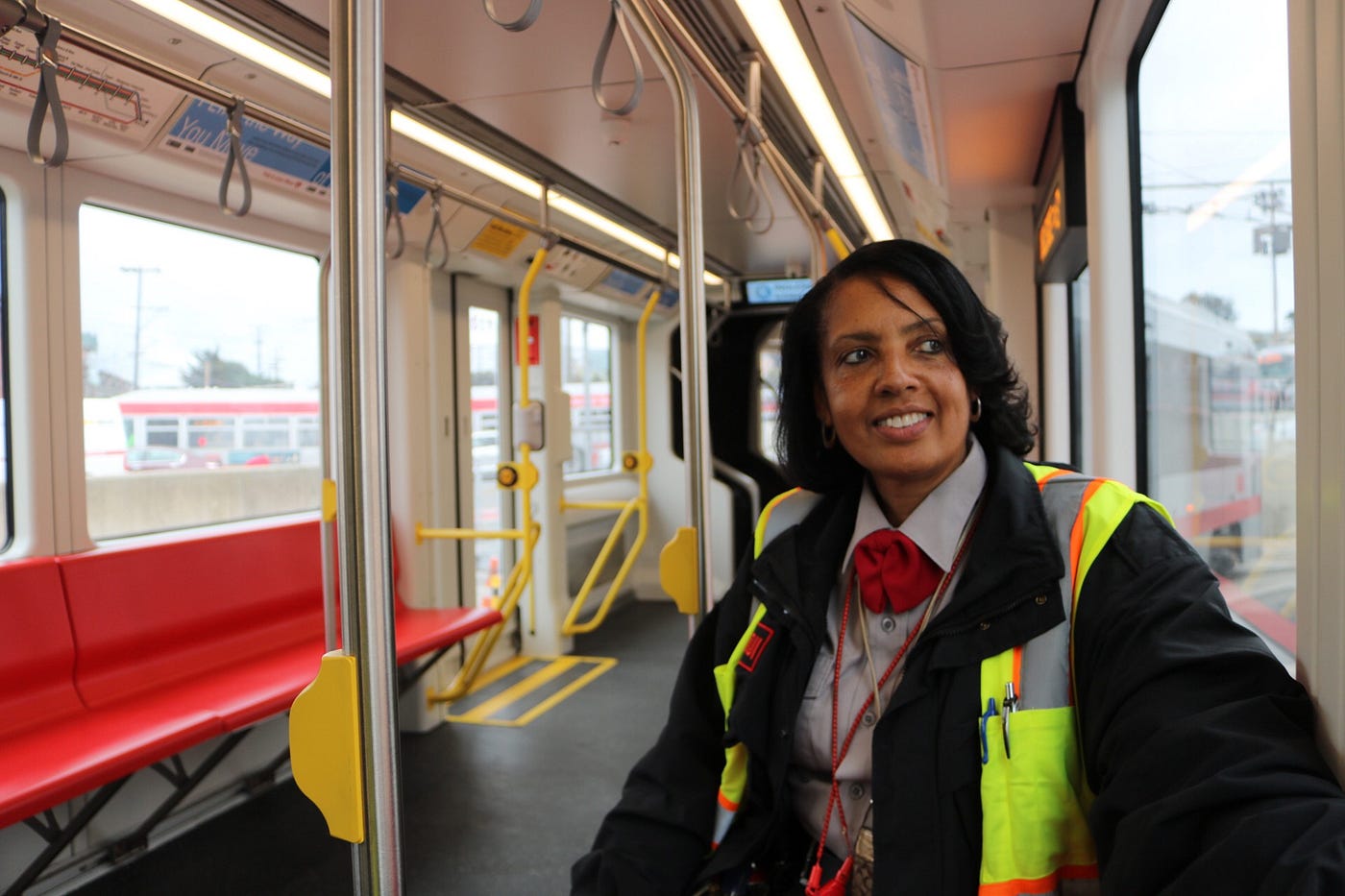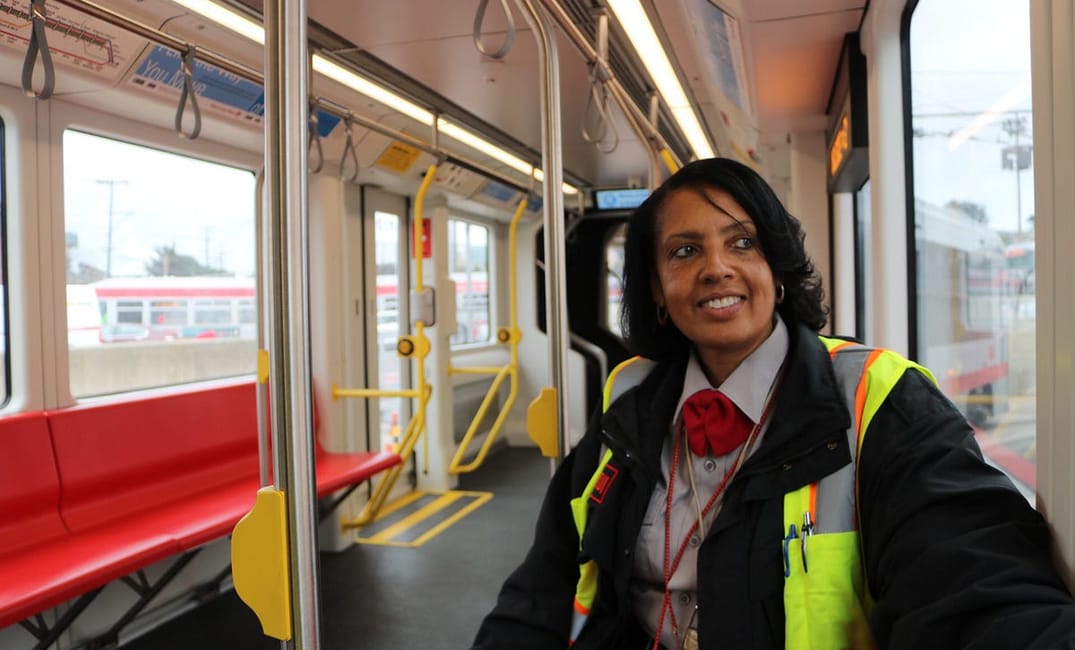
“A guy starts taking his pants off and squatting down. I’m looking in the rearview mirror and telling him, ‘Please do not do that.’ But what does he do…?”
Telesia Telsee, more commonly known as Lisa, closes her eyes and nods silently. She’s been working as a Muni operator since 2001—and she’s witnessed it all.
“I’ve seen a lot of changes over the years,” she said as the KT Muni train beeped and the doors closed.
To better understand what life is actually like as a Muni driver today, Telsee has invited me to tag along on her ride as we shadow another operator. We’re sitting down in a shiny new seat of an LRV4, one of the recently rolled-out “light-rail vehicle” trains of the SFMTA, and just agreed to do the entire KT-Ingleside-Third Street line, which takes about three hours in total. From Bayshore Boulevard and Sunnydale Avenue to San Jose and Geneva Avenues, I watched the morning commuters hop on and off the train, survived a few traffic jams and learned a whole lot about the job.
A born-and-raised San Franciscan, Telsee recalls taking the bus as a student to Lincoln High School—a time when drivers knew local riders, she said, and people talked to each other during their commute.
“Nowadays, everyone is just into their phone,” she lamented. As an avid Muni rider myself, this wasn’t new news. The silent, head-down, earbuds-in commuter is more common than I’m comfortable with, but I get it. Mornings suck, and Instagram helps to take the edge off. Thankfully, despite my tech addictions, there are regular riders who show appreciation, Telsee told me, saying hello each morning and even bringing her a bottle of wine during the holidays.
“A lot of drivers have a schedule that they want to keep, but the rule I was taught was safety first.”
Depending on the route and the luck of the driver, tuned-out commuters are the least of their worries. With the way the mirrors are set up on the Muni trains, it’s difficult for the driver to see past the first car.
“They can be doing anything, whether it’s getting high, smoking, playing music—the list goes on,” she said. Among the more dangerous routes, according to Telsee, are the 19 Polk, the 6 Haight/Parnassus, the 9 San Bruno … plus, as she told me with a sly smile, “The one you’re on.”
Every operator has a different story, and it seems like the bad ones outweigh the good. Of course, safety for Muni drivers is a big concern.
“We do not have enough protection from violence, threats or mentally challenged passengers,” Telsee said, noting that when trouble arises on a vehicle, the driver has to notify someone at the central hub, who then dispatches the SFPD to the nearest stop. But tense situations happen often on SF public transit, and not having immediate backup often puts drivers at risk, she said. One of her lowest memories, aside from the one passenger who turned the train car into a bathroom, was when someone spit on her when she asked them to put out a cigarette.
“That hurt my heart,” she said. “We don’t come to work for that.”
Despite the aloof pedestrians who are more interested in their technology and the crazy-ass bikers owning the streets of SF, Telsee has been an accident-free driver since joining Muni in 2001. What’s her secret?
“A lot of drivers have a schedule that they want to keep, but the rule I was taught was safety first,” she said.
And she really means it. Telsee points out ways to improve the passenger experience in the new trains, such as stickers to help new riders know how to find the stop-request button and clearer language on the emergency-call buttons. Both of these ideas make total sense to me, so when I asked why they weren’t implemented to begin with, she mentioned a disconnect between upper management (who were involved in the designing of the cars) and experienced operators like her. She didn’t harp on it too hard, but as she was pointing out all her ideas, I couldn’t help but notice the chasm between those who sit in the office dictating the way Muni should work, figuratively in the driver’s seat, and those sitting on the road, literally in the driver’s seat.
In terms of how Muni operators get assigned routes, new drivers are put through a 60-day training period, which is followed by a written and driving test. Depending on their scores and the needs at that time, those with higher scores may get to pick their division. In general, Telsee explained, “You go where you’re asked to go.”
For the most part, operators drive the same route at the same time each day in 8-to-12-hour shifts. As time goes on and new routes open up, operators can ask to be transferred. Telsee drove in the Presidio division for six years, and when a spot in the rail division opened in 2007, she put in a request to transfer.
When I asked Telsee for one thing she’d like to see improved on Muni, her answer was simple: respect.
Coming from a self-proclaimed family of workaholics, Telsee works six days a week and is a proud homeowner in the City. To make her hectic schedule work, she sometimes wakes up at 3:00 a.m. to make sure her two beloved pit-bull pups get decent exercise. But having some fun is important as a release from her hard work.
“I don’t party-party,” she said at first, and then later told me about booking the convertible-style Embarcadero streetcar to celebrate our dearly departed Prince’s birthday next month. TBD on whether or not purple velvet will be the theme.
Two-thirds of the way into our loop, I finally felt comfortable enough to ask Telsee about the topic that’s been burning in my mind: pay. Long ago, I heard the rumor that Muni drivers get paid six figures. In fact, I’ve always reminded myself of it when I see the drivers putting up with the usual shit that goes down on Muni. Turns out, that’s not the truth — at least, not always. Drivers get paid on the basis of their route and the length of time they’ve worked with the SFMTA, now the overarching authority of Muni. So while some certainly make over 100,000, many do not. I learned that the rumor stemmed from a 2010 ballot measure called Prop G, which aimed to ease recession tension by decreasing the power of the union that represents Muni drivers, lowering the starting salary for drivers, and removing a lot of the perks associated with driving for Muni.
With the passing of that 2010 prop, alot of things changed, including a change that mandated a smaller salary — think $24 an hour—for new drivers that increases slowly over a five-year period, which has led to serious issues for some of our beloved drivers. This waiting time puts financial stress on operators looking to make ends meet in San Francisco, Telsee said. To afford a life now, it’s not uncommon for drivers to live in faraway galaxies like Tracy and Modesto, which means that after navigating a bus or train through SF’s madness for 8 to 12 hours, they then have to drive another hour-plus just to get home.
When I asked Telsee for one thing she’d like to see improved on Muni, her answer was simple: respect. Muni operators play a big role in the city, but once they get in the driver’s seat, they’re at the whim of the streets and the people of San Francisco. “When you’re on rails, you have no control if there’s police activity and the line is stopped,” she said. This is the part that we Muni riders, when we’re late and stressed about our own lives, often forget.
As we sat and chatted on the moving train, a distracted driver almost took a left (illegal) turn into our rail line. The driver of our train, Emma, was paying attention and stopped the train just in time, and I was reminded once again of the human behind that plexiglass driver’s shield. At the next stop, she jumped out to take a quick breath of fresh air and shake it off. The potential collision had been even closer than I’d realized.
“This happens on Third Street all the time,” Telsee said casually. I guess it’s just another type of bullshit that Muni drivers are used to.







